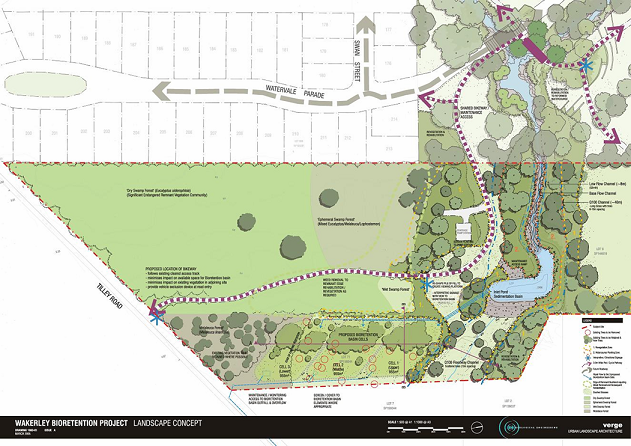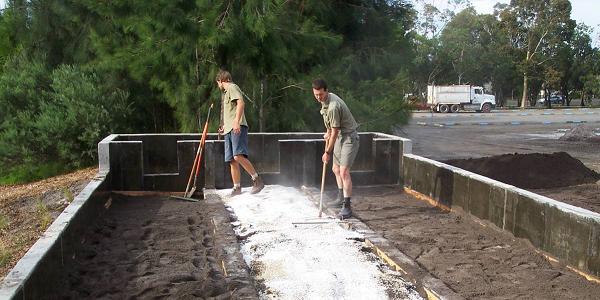|
|
|
Project 4: Demonstration and Testing
Key Messages
Field Trials
A key aim of FAWB’s research was to develop biofiltration technologies that provide effective and sustainable treatment of stormwater. Bioretention systems are a form of biofilter that are becoming widely used owing to their efficiency and adaptability to urban landscape design.
We used a combination of laboratory experiments and field trials of bioretention systems to test the influence of design configurations and operating conditions, and to demonstrate their full-scale applications.
The field trials have being documented, to provide guidance on construction, operation and maintenance of biofiltration systems, for achieving long-term performance and sustainability.
Aims of Field Trials
A number of field trials of bioretention systems in Melbourne, Sydney and Brisbane were undertaken to:
- Validate laboratory studies and address site specific issues
- Provide demonstrations of bioretention systems in a range of urban environments (streetscapes, greenfields, inner-city retrofits, etc)
- Provide the basis for monitoring of long-term robustness under real operating conditions
- Document construction procedures, for use in guidelines and standard drawings
Bioretention for stormwater harvesting (Melbourne)
A bioretention system was constructed to treat stormwater runoff from a car park, prior to its harvest for reuse.
This system was designed as three separate cells allowing field-scale trials of biofilter media (including additives) and hydraulic loadings.
Mixing trial filter media for field comparisons
Bioretention system in sodic soil environment (Sydney)
The application of bioretention systems in sodic soil environments requires particular attention to preventing any increases in discharge to groundwater and leaching of saline water into receiving waters.
Field trials were undertaken to investigate if special construction techniques need to be adopted in constructing bioretention systems in sodic soil environments.
Large-scale bioretention system (Brisbane)
This regional-scale bioretention system treats stormwater runoff from an 87ha residential catchment. Specifically, this trial will examine the effectiveness of an anaerobic zone for removal of nitrogen from urban stormwater.
The system was designed with three hydraulically separate filtration cells, each with a different sub-surface drainage configuration and vegetation specification thus providing a unique monitoring

- In field applications, biofilters may demonstrate high variations in hydraulic performance due to different specifications of filter media characteristics, and poor construction and maintenance practices (43% of tested existing systems have field infiltration capacity below 50 mm/hour).
- Site characteristics such as filter area (relative to catchment area), age and inflow volume were not useful predictors of long term conductivity. Rather, the initial conductivity of the filter media was found to be far more indicative of a biofilter's long-term performance.
- To ensure reliable operation of bioretention systems, filter media specifications must be adhered to in terms of both composition and hydraulic conductivity. FAWB has produced such specifications that will be updated as required to reflect new and relevant research insights. Dispersive clay and silt from the Western Sydney area are generally unsuitable material for creating bioretention filter media owing to their unreliability in maintaining media hydraulic conductivity. Furthermore, it is important to tests soils prior their installation (see Project 1, Key Message 6).
- Vegetation was shown to be critical in maintaining the infiltration capacity of biofiltration systems, helping them to recover from the inevitable reduction in hydraulic conductivity due to initial compaction of the filter media under hydraulic loading. The creation of macropores due to root growth and senescence is thought to contribute to this behaviour.
- Vermiculite and perlite were also found to help maintain filter media hydraulic conductivity, making the biofilter more robust to slight deviations from the specified filter media characteristics.
- There will be leaching of silt and some pollutants over the establishing phase. The flushing of solids should cease within 3-6 months in most cases (dependent on the amount of rainfall during this period).
- Bioretention systems constructed in sodic soil without impermeable lining are not at risk of exporting salt from insitu soil into local streams.
- Effective communication between designers and construction contractors is essential, throughout all stages of the project. It is imperative that quality control issues are addressed in planning and design, construction and maintenance throughout the life of the bioretention system, and that the design intent is communicated to the contractors, at a pre-construction briefing.
- Maintenance requirements could be high during the establishment phase; frequent weed removal is required and the juvenile vegetation should be watered during extended dry periods. However the need for this level of maintenance reduces significantly as the vegetation matures. The development of mosses on the surface should be discouraged, as these can reduce the hydraulic capacity of the system. Dense planting of the preferred plants at the time of construction will help to minimise the extent of weed invasion, and minimise any moss growth.
Project 1 | Project 2 | Project 3 | Project 4
|

